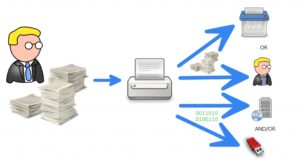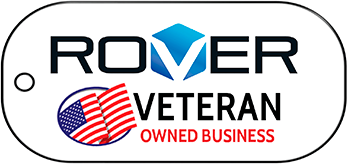Are your company’s records getting out of hand? If finding certain pieces of information within a large amount of records is difficult to do then maybe it’s time for you to look into document imaging services—one of the most convenient ways for your business to maintain its immense quantity of records.
Document imaging is the process of digitizing paper documents and turning them into electronic media files that can be accessed in a variety of ways, depending on your company’s specific needs. With this being said, this is how it works.
Document Imaging Process
When a company needs its paper records turned into digital form, it contacts a document imaging service provider and either brings the records to the imaging facility itself or has the records picked up and delivered to the facility. From here, an image capturing system scans and converts the documents into an electronic format. The digital records can then be stored and accessed in two ways:
- Storing them online, with access through the imaging provider’s website
- Having the records returned via some sort of electronic media vehicle, such as a flash drive
Whether a company wants its electronic records stored online for easy access or physically returned on some sort of drive will depend on each client’s needs.
Storing Electronic Records Online

Storing company records online is done through an online database such as iSilo and iChamber. With databases like these, companies are able to access their digital records online any time and perform searches for desired sections of information. These divided sections of information are called index fields. If a client wants to perform a more specific keyword search, an optional feature called optical character recognition (OCR) can be added. This image to text feature is able to search for specific words or letters throughout the documents and can even sometimes read handwriting scanned in from the paper records. Instead of taking valuable time to search for hidden documents and pieces of information, document imaging allows for you to have them all at your fingertips.
Is this records management practice secure? It should always be, as document imaging companies use secure connections for these databases. Just check for the ‘https’ protocol in the url to make your records are indeed secure.
What if the server goes down or something catastrophic happens to the records stored in this online database? Document imaging companies should be using a redundant backup of the records stored here. This type of backup usually stores the records in multiple servers to ensure that they are protected.
End State of Paper Records
Once the records are successfully converted into a digital format, the client then must determine what it wants to do with the paper records. There are multiple options to consider at this point. The client can either:
- Have the paper records returned
- Have the paper records destroyed via secure shredding
- Have the paper records stored in a records storage facility
Determining what to do with these oftentimes bothersome paper records is based on the clients’ needs and the imaging company’s services. Any imaging company can return the paper records to the client, no problem. But what you really might be looking for is a service provider that also doubles as a secure shredding and records storage facility.

Document Imaging, Records Storage and Secure Shredding
Although your paper records might be converted into an electronic format, you might have a need to either keep them around for a while or shred them. If this is the case, you should probably find an imaging company that can also accommodate these services. Otherwise, you could be burdened with paying to have the paper records returned, finding a separate records storage facility and paying to have the records picked up and delivered to this new location.
One convenient and cost effective advantage of using this type of provider is the option to store all of your paper records, while imaging only the ones you need digitized. This cuts back on the initial cost of imaging. For example, out of a hundred boxes of paper records, you have the option to store 80 and image 20. Moving forward, you can later request imaging of paper records as you need them. This is called ‘scan on demand’ and is an option only available with a document imaging provider that doubles as a records storage facility.
In addition, many secure shredding facilities follow regulations set forth by the National Association for Information Destruction (NAID). Finding a provider that complies with these protocols ensures that your records will definitely be secure. Some areas NAID focuses on are:
- Particle size of your shredded records
- A background check of seven years on all access employees
- Security of transportation vehicles
- Video surveillance in the shredding facility (if using offsite document imaging)
Document Imaging Cost
While the time it takes to complete the entire document imaging process can vary between projects, so can the cost. In fact, both of these factors are dependent upon multiple variables:
- The Volume of paper records that need to be imaged
- The number of Index Fields that the electronic records need to be divided into
- The End State of the paper and digital records
- The Age (Physical Condition) of the paper records
As cost is one of the biggest topics when determining whether or not your company really needs to use document imaging services, figuring out what drives the cost is vital, although tricky. In terms of volume, paper records are usually priced per page. A standard archives box (1.2 cube) generally contains around 2,500 pages. This, however, doesn’t mean that there is necessarily a set price for a certain amount of paper records.
For example, when determining the cost of the job, if a document imaging company finds that any of the paper records require more preparation before imaging (if they are folded, torn, have staples in them, etc.) then the cost will rise. The more index fields that a client wants the electronic records to be divided into, the higher the cost. Whether a client wants the paper records to be returned or shredded after being digitized will also increase the overall cost of the project. Of course, one way for a company to control the cost a bit would be to transport the paper documents itself rather than have the document imaging provider pick up and return them, shred them or store them. To put it bluntly, determining the pricing for document imaging services is not as straightforward as it initially might seem.
Even though determining the cost of document imaging may require a thorough analysis of your paper records and company needs, it can pay off in the end.
Rover Records Management provides its clients with document imaging services, as well as a records storage facility and secure shredding. Contact Rover to find out more about taking charge of your company’s paper records.






